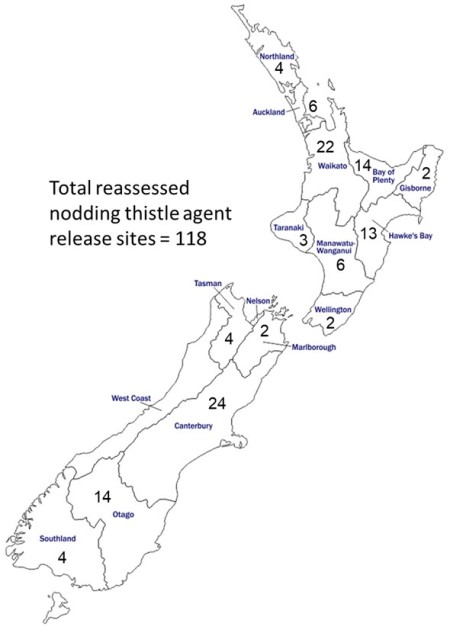Comparing nodding thistle then and now
We have developed a uniquely New Zealand approach to achieving a cost-effective, but respectable, level of monitoring of past, apparently successful weed biocontrol programmes. This is achieved by collaborating with the National Biocontrol Collective (represented by 15 regional councils, unitary authorities and DOC) to revisit large numbers of the original release sites. Since the 1980s, Manaaki Whenua – Landcare Research, together with its stakeholders, has maintained a comprehensive database of release sites for weed biocontrol agents, particularly in the decade or so after their first release. The information stored in this database is not as high quality as we would gather for a flagship monitoring programme, but the size and geographical spread of the available data sets lend considerable statistical and interpretative power. We developed and refined this ‘release site revisit’ assessment method with the ragwort (Jacobaea vulgaris) biocontrol programme, and more recently we have applied it to the nodding thistle (Carduus nutans) biocontrol programme.

Distribution of nodding thistle sites for assessment
Nodding thistle was the most aggressive pasture weed in the drier areas of New Zealand after it spread widely in the 1950s and 1960s. New Zealand introduced biocontrol agents against nodding thistle in 1972 (nodding thistle receptacle weevil, Rhinocyllus conicus), 1984 (nodding thistle crown weevil, Trichosirocalus horridus) and 1990 (nodding thistle gall fly, Urophora solstitialis). There were quite widespread reports of declines in nodding thistle abundance several years after establishment of the nodding thistle crown weevil in particular, but the thistle seemed to remain a serious pasture weed in some parts of New Zealand, and rigorous quantitative, nationwide data have been conspicuously absent.
Recently, we applied our post-release monitoring approach, and mined our release database for information on release sites for nodding thistle crown weevil and nodding thistle gall fly (the release of nodding thistle receptacle weevil pre-dated the database). Then we asked our regional council collaborators to try to revisit a subset of around 70 release sites with assessment questionnaires on nodding thistle, its biocontrol agents, and various land-management issues. Revisits were planned over two consecutive – or near consecutive – years to avoid single-season anomalies or site disturbances that might have dramatic effects on the local abundance of nodding thistle as a short-lived, mostly biennial weed. Where possible, landowners were asked a range of questions on their weed and pasture management, and their awareness of biological weed control. The nodding thistle release site revisits ran from 2013 to 2021, with some later delays due to Covid restrictions. Overall, the team achieved an excellent set of returns covering the country well. The West Coast is an easily explained blank as it is too wet for nodding thistle to be a significant pasture weed.
For the analysis we ended up combining the data sets for the nodding thistle crown weevil and nodding thistle gall fly release sites. It was obvious from the data that the agents had spread to many of the sites where the other agent was released, so distinguishing site effects that related to the original agent species released was going to be impossible. There was also no apparent difference between the data from the sites where each agent had been first released (e.g. in terms of reductions in nodding thistle density). We ended up with 118 sites across New Zealand where we had good records of nodding thistle density within 4 years of the release of either nodding thistle crown weevil or nodding thistle gall fly, and good recent surveys of thistle density over (mostly) 2 years.
“Perhaps the most critical question we can answer with this new data set is the extent to which nodding thistle density declined across New Zealand since the biocontrol agents were introduced,” said Simon Fowler, who conducted the data analysis. “We can reveal that average nodding thistle density at sites within 3 years of the release of the crown weevil or gall fly (1988–1998) was 3.1 plants per square metre, and that this had dropped to 0.65 plants per square metre (a 78.9% reduction) when the sites were revisited from 2013 to 2021,” explained Simon. The data also showed that there are still some heavily infested nodding thistle sites, even after biocontrol. There was no apparent geographical variation in this pattern, and no obvious effect of factors (such as land use) that could readily explain the continued high densities of nodding thistle at a few sites.
It is important to emphasise that the dramatic mean reduction in nodding thistle densities of 78.9% in these data, although consistent with the time period when biocontrol would be expected to act, cannot be linked causally to biocontrol, and could be caused wholly or in part by other factors. We can, however, examine what was happening to other thistle species while this large decline in nodding thistle was happening, as we asked land managers whether the status of other thistles as weeds had increased, decreased or remained the same. The most abundant other pasture weed at our sites was Californian thistle, and this was of interest because it has not been under any significant biological control throughout the majority of the years of the current study. Our rationale is that if the 78.9% reduction in nodding thistle was due to land management changes (e.g. better thistle control methods, improved pasture management), then we would expect to see some parallel reduction in Californian thistle.
In the data there was no indication that Californian thistle increased or decreased to a greater or less extent at sites where nodding thistle had decreased compared to sites where nodding thistle had increased. The lack of change of Californian thistle in parallel to the reductions in nodding thistle adds some support to the nodding thistle reduction being caused by host-specific biocontrol agents, and also suggests there was no major ‘replacement weed’ effect, whereby Californian thistle infestations simply replaced nodding thistle after its successful suppression due to biocontrol.
Nodding thistle crown weevil
Our recent site reassessments asked land managers about their efforts to control nodding thistle, both currently and (if known) in the past. It is clear from the data that substantial control of nodding thistle is ongoing at some sites across New Zealand. About a quarter of sites (24%) reported recent use of relatively indiscriminate spraying (boom spraying at ground level or aerial spraying), whereas over two-thirds of sites (68%) reported using spot herbicide treatments. As with the data on reductions in nodding thistle abundance, there was no obvious geographical variation in the extent of ongoing nodding thistle control by land managers, and no obvious effect of factors such as land use. At 34 sites we had sufficient information from land managers on expenditure on herbicides, labour or spray contractors for us to estimate annual nodding thistle controls costs as ranging from zero to $50,000 per site. Overall, about half of land managers (53%) reported that they now sprayed less (or didn’t spray at all) for nodding thistle, and half (47%) did not report any reductions in use of herbicides against nodding thistle. No sites reported an increase in spraying for nodding thistle.
We extended our economic analysis by assuming that the approximately 50% of sites where decreased spraying for nodding thistle was reported were benefiting from biocontrol. Conversely, we suggest that the approximately 50% of sites where spray regimes appear to be unchanged would be benefiting far less from biocontrol, because their higher use of herbicides (particularly indiscriminate boom/aerial applications) would prevent good population build-up of biocontrol agents. A measure of the annual cost savings in nodding thistle control per site from biocontrol is then the difference ($11,100) between the mean annual spray costs of the low-herbicide-use sites where biocontrol can operate ($1,700) and the high-herbicide-use sites where biocontrol is compromised ($12,800). If this annual saving in nodding thistle control costs is being achieved on just 10% of New Zealand’s 23,400 sheep and beef farms, then the current, ongoing national cost saving is $26 million per year. Present-value calculations, even considering the early costs of introducing the agents in the 1970s, 80s and 90s, still give us a huge benefit:cost ratio for the complete nodding thistle biocontrol programme in New Zealand of 580:1.
This project was jointly funded by the National Biocontrol Collective and the Ministry for Primary Industries’ Sustainable Food and Fibre Futures Fund (Grant #20095) on multi-weed biocontrol.

